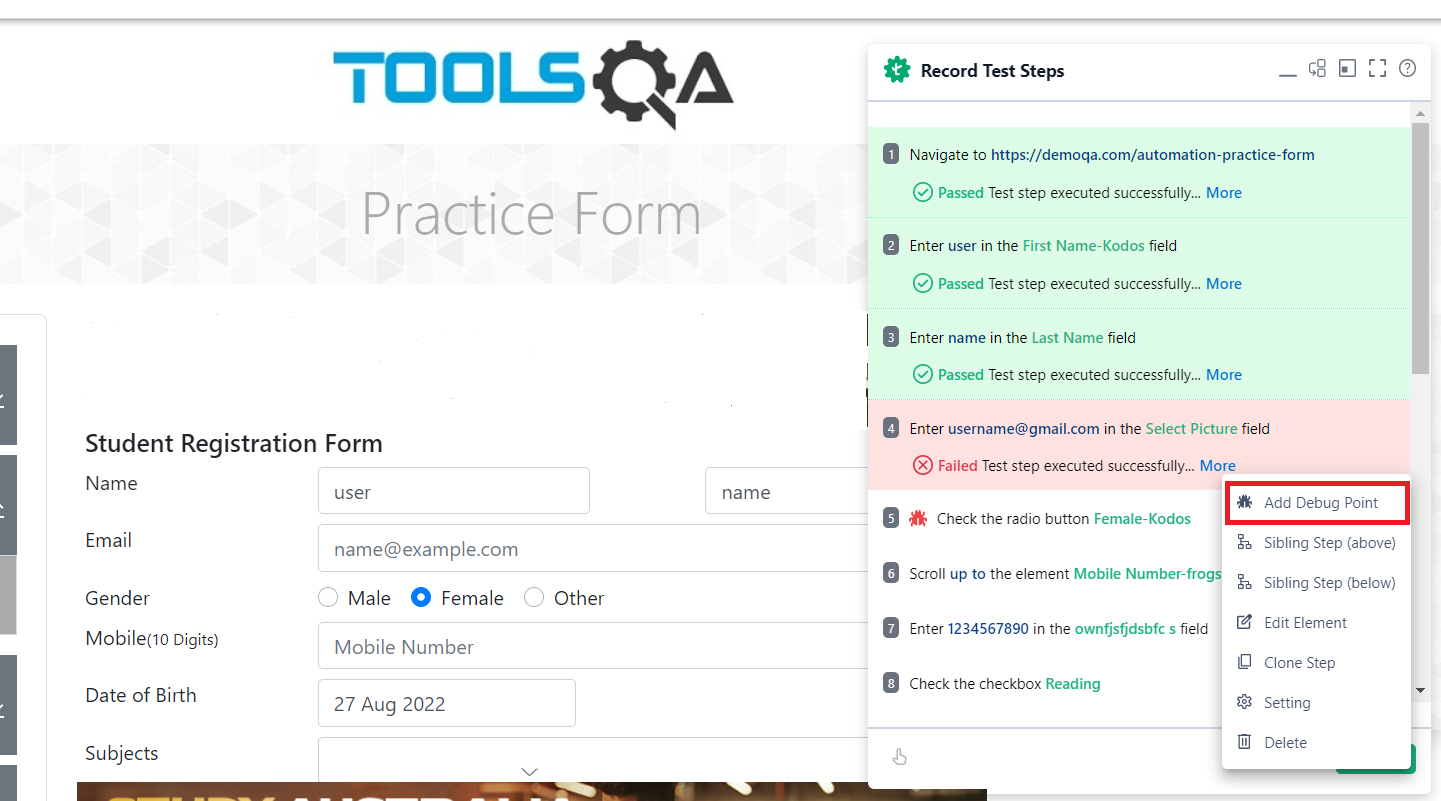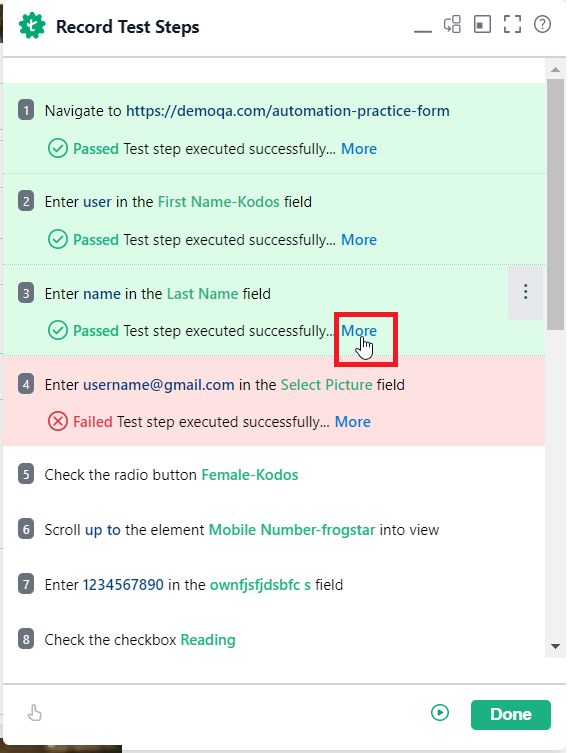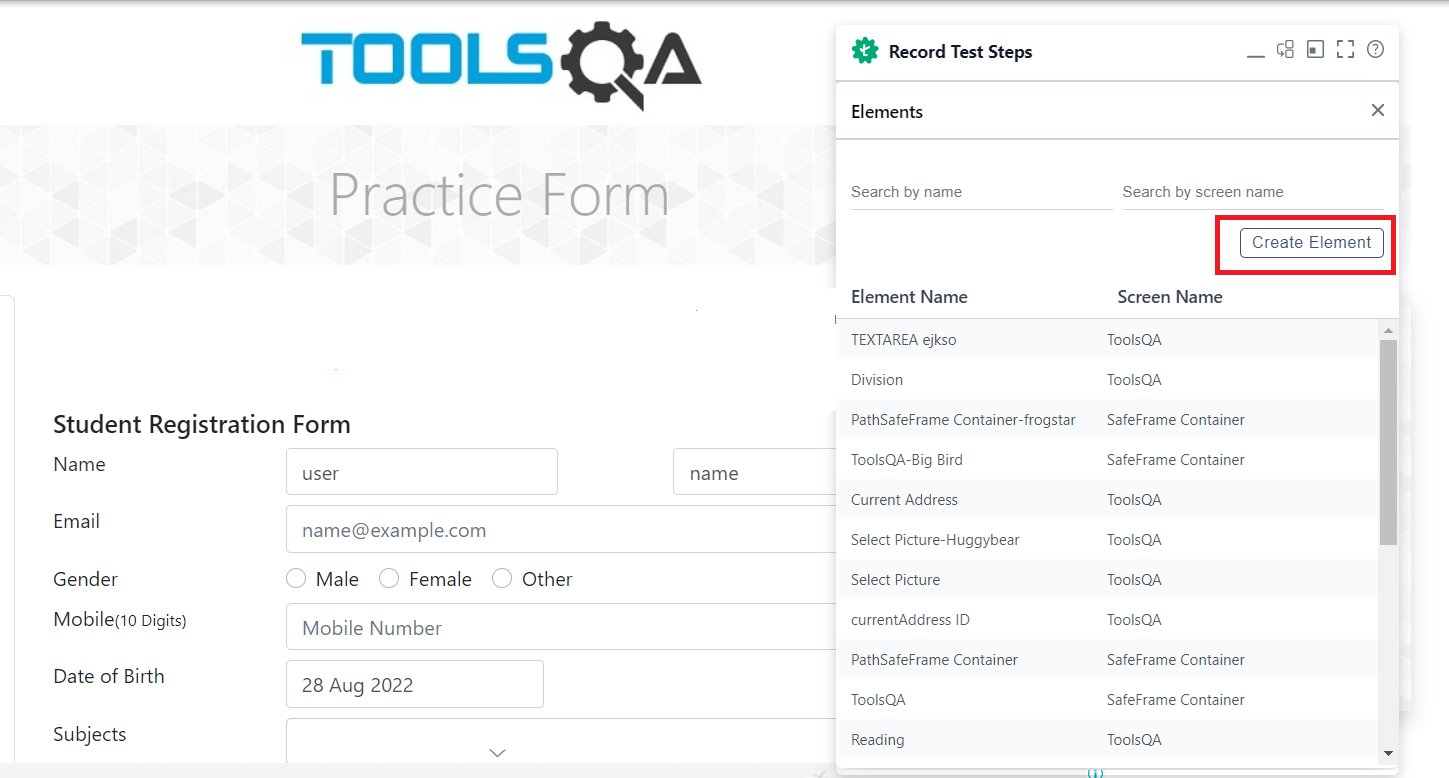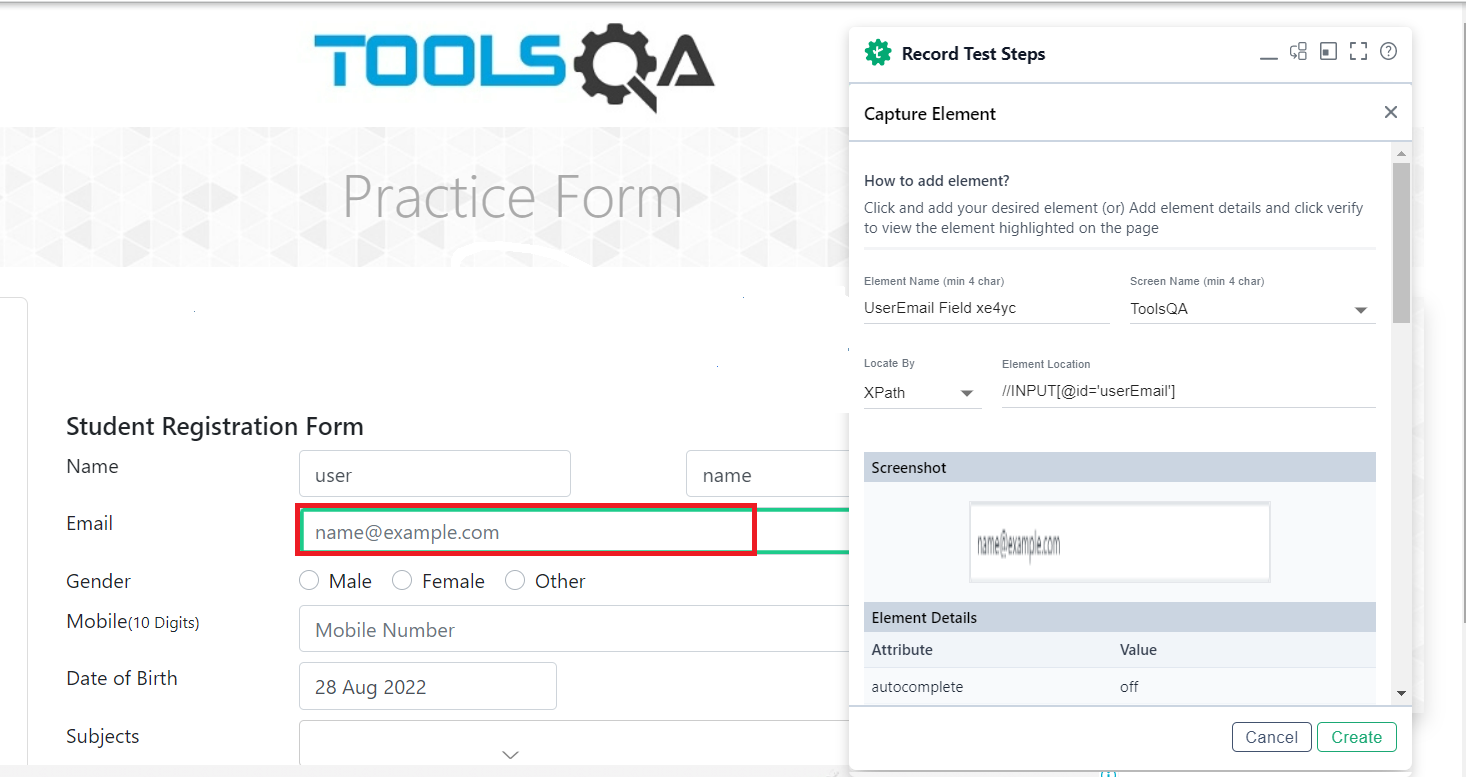- collaboration
Invite Team Members
Assign Projects
Users & Role Management
Review Management [Test Cases]
Review Management [Elements]
Execution Controls
Manage Test Cases
Test Case List Actions
Import and Export Test Cases
Import Test Project Test Cases
Importing Postman Collections and Environments
Update Test Case result in a Test Plan
Test Cases (Mobile Web App)
- Test Step Types
Type: Natural Language
Type: REST API
Type: Step Group
Type: For Loop
Type: While Loop
Type: Block
Type: If Condition
Nested Step Groups
Image Injection
Cross-application testing
- Test Data Types
Raw
Parameter
Runtime
Random
Data Generator
Phone Number
Mail Box
Environment
Concat Test Data
Create Test Data [Parameter]
Update Test Data Profile
Updating Value in TDP
Import TDP
Bulk Deletion of a Test Data Profile
Create Test Data [Environment]
- Elements (Objects)
- Web Applications
Record Single Element
Record Multiple Elements
Create Elements
Supported Locator Types
Formulating Elements
Shadow DOM Elements
Verifying elements in Chrome DevTools
Handling iframe Elements?
Dynamic Locators using Parameter
Dynamic Locators using Runtime
Using Environment Test Data for Dynamic Locators
Locating Dynamic Elements in Date Widget
Freeze & Inspect Dynamic Elements (WebPage)
Locating Dynamic Elements in Tables
Import/Export Elements
AI Enabled Auto-Healing
Locator Precedence (Web Apps)
Verify Elements from Test Recorder
- test step recorder
Install Chrome Extension
Install Firefox Extension
Install Edge Extension
Exclude Attributes/Classes
- test plans
Add, Edit, Delete Test Machines
Add, Edit, Delete Test Suites
Schedule Test Plans
Run Test Suites In Parallel
Cross Browser Testing
Distributed Testing
Headless Testing
Test Lab Types
Disabling Test Cases in Test Plans
AfterTest Case
Post Plan Hook
AfterTest Suite
Email Configuration in Test Plan
Execute Partial Test Plans via API
Ad-hoc Run
Test Plan Executions
Dry Runs on Local Devices
Run Tests on Private Grid
Run Tests on Vendor Platforms
Run Test Plans on Local Devices
Test Locally Hosted Applications
Debug Test Case Failures
Parallel and Allowed queues
- debugging
Debug results on local devices (Web applications)
Debug Results on Local Devices
Launch Debugger in the Same Window
- Testsigma Agent
Pre-requisites
Setup: Windows, Mac, Linux
Setup: Android Local Devices
Setting up iOS Local Devices
Update Agent Manually
Update Drivers Manually
Delete Corrupted Agent
Delete Agents: Soft & Permanent
Triggering Tests on Local Devices
- troubleshooting
Agent - Startup and Registration Errors
Agent Logs
Upgrade Testsigma Agent Automatically
Specify Max Sessions for Agents
Testsigma Agent - FAQs
- continuous integration
Test Plan Details
REST API (Generic)
Jenkins
Azure DevOps
AWS DevOps
AWS Lambda
Circle CI
Bamboo CI
Travis CI
CodeShip CI
Shell Script(Generic)
Bitrise CI
GitHub CICD
Bitbucket CICD
GitLab CI/CD
- desired capabilities
Most Common Desired Capabilities
Browser Console Debug Logs
Geolocation Emulation
Bypass Unsafe Download Prompt
Geolocation for Chrome & Firefox
Custom User Profile in Chrome
Emulate Mobile Devices (Chrome)
Add Chrome Extension
Network Throttling
Network Logs
Biometric Authentication
Enable App Resigning in iOS
Enable Capturing Screenshots (Android & iOS)
Configure Android WebViews
Incognito/Private mode
Set Google Play Store Credentials
- addons
What is an Addon?
Addons Community Marketplace
Install Community Addon
Prerequisites(Create/Update Addon)
Create an Addon
Update Addon
Addon Types
Create a Post Plan Hook add-on in Testsigma
Create OCR Text Extraction Addon
- configuration
API Keys
- Security(SSO)
Setting Up Google Single Sign-On(SSO) Login in Testsigma
Setting Up Okta Single Sign-On Integration with SAML Login in Testsigma
Setting up SAML-based SSO login for Testsigma in Azure
iOS Settings
Creating WDA File for iOS App Testing
- uploads
Upload Files
Upload Android and iOS Apps
How to generate mobile builds for Android/iOS applications?
- Testsigma REST APIs
Environments
Elements
Test Plans
Upload Files
Get Project Wide Information
Upload & Update Test Data Profile
Fetch Test Results (All Levels)
Trigger Multiple Test Plans
Trigger Test Plans Remotely & Wait Until Completion
Run the Same Test Plan Multiple Times in Parallel
Schedule, Update & Delete a Test Plan Using API
Update Test Case Results Using API
Create and update values of Test Data Profile using REST API
Rerun Test Cases from Run Results using API
- open source dev environment setup
macOS and IntelliJ Community Edition
macOS and IntelliJ Ultimate Edition
Windows and IntelliJ Ultimate Edition
Setup Dev Environment [Addons]
- NLPs
Retrieve Value in Text Element
Capture Dropdown Elements
Unable to Select Radiobutton
Unable to Click Checkbox
Clearing the Session or Cookies
UI Identifier NLP
Drag & Drop NLP
Uploading Files NLP
- setup
Server Docker Deployment Errors
Secured Business Application Support
Troubleshooting Restricted Access to Testsigma
Why mobile device not displayed in Testsigma Mobile Test Recorder?
Unable to Create New Test Session
Agent Startup Failure Due to Used Ports
Tests Permanently Queued in Local Executions
Fix Testsigma Agent Registration Failures
Testsigma Agent Cleanup
Need of Apache Tomcat for Testsigma Agent
- web apps
URL not accessible
Test Queued for a Long Time
Issues with UI Identifiers
Missing Elements in Recorder
Collecting HAR File
Errors with Browser Session
Page Loading Issues
- mobile apps
Failed to Start Mobile Test Recorder
Troubleshooting “Failed to perform action Mobile Test Recorder” error
Test Execution State is Queued for a Long Time
Mobile app keeps stopping after successful launch
More pre-requisite settings
Unable to start WDA Process on iPhone
Most Common causes for Click/Tap NLP failure
Finding App Package & App Activity (Android)
Cross-environment Compatible ID Locators (Android)
Why Accessibility IDs Over other Locators?
Common Android Issues & Proposed Solutions
Finding the App Bundle ID for iOS
- on premise setup
On-Premise Setup Prerequisites
On-Premise Setup with Docker-compose File
Post-Installation Checklist for On-Premise Setup
Install Docker on an Unix OS in Azure Infrastructure
SMTP Configuration in Testsigma
Configure Custom Domains
- salesforce testing
Intro: Testsigma for Salesforce Testing
Creating a Connected App
Creating a Salesforce Project
Creating Metadata Connections
Adding User Connections
Build Test Cases: Manual+Live
Salesforce Element Repositories
Intro: Testsigma Special NLPs
Error Handling On Metadata Refresh
Automating Listview Table NLPs
- windows automation
Intro: Windows Desktop Automation
Windows (Adv) Project & Application
Object Learning (Using UFT One)
Converting TSR Files to TSRx
Importing/Updating TSRx Files
Test Cases for Windows Automation
Error Handling Post TSRx File Update
Debug results on local devices (Web applications)
Debugging issues in complex test cases might require enhanced techniques. This article describes Testsigma's interactive debugging feature for web applications that will not only fix test step issues but also save a good amount of debugging time.
This feature is available in beta version only. Contact support for enabling the feature in your account.
Steps to execute test cases in debugger mode
-
Navigate to the test case you want to debug and interact with.
NOTE:If the test case uses a test data profile, users can choose only one data profile to use the debugging feature.
- On the test case details page, click the drop-down arrow beside the Run button.
- Select Run in debug mode from the drop-down list.

Optionally you can select Record in debug mode to capture screen shots during test execution for each UI-interactive action. Looking at the screen shots it is easier to identify where your test cases failed.
-
On the Ad-hoc run overlay window,
- Specify the test lab. The default test lab in debugging mode for web applications is Local Device.
- Select the checkbox Run only if the configured browser version is available in the Agent machine.
- Select your local test machine. To run tests on your local machine you need to set up a Testsigma agent. For more information, refer to set up Testsigma agent.
- If you want to execute the test steps until the failed step, select the toggle Run till failed step. If this toggle button is disabled, the test case will be executed from start to end. Thereby, identifying the test step that is failing would be difficult.
- If you want to execute the step till a particular step (that is setting a debug point), select the step from the Run till step drop-down list. For more information on debug points, refer to the section debug points.
- Click Run now to execute the test case.
Adding debug points to debug the test
Debug points are locations in your test steps where you want the test step to start or pause test case executions. This helps to observe the behavior of the test case. Multiple debug points can be added in a test case. Breaking up test execution this way ensures that you can carefully investigate each of the steps for potential bugs, instead of using a more inconvenient alternative. For example, letting the test case run at once and then trying to figure out in which step the things went wrong. To add debug points to your test case, follow the below steps:
- To add a debug point, click on the Show more icon next to the test step.
- Select Add debug point from the drop-down list. When the test case is executed, the execution is performed until the debug point. Multiple debug points can be added as and when desired.

Fixing an error using debugging feature
On the execution of the test case, a user can visually view the execution move from step to step. Thus, it is easy to understand the execution workflow. The execution is paused when an error is encountered or at a debug point. On the test steps window, Testsigma highlights the step that failed and caused the execution to stop. With the execution paused, the debugging feature offers various resources to help you debug the error in the test step.
Debug resources
The debug resources provide a detailed and interactive analysis of the issue. The debugging resources include step results, metadata, screenshots, source codes, and step settings. These resources are available for all test steps including passed and failed test steps.
- To view the debugging resources, click More.

- Hover the mouse over each icon to find the details related to step results, metadata, screenshots, source codes, and step settings.
Troubleshoot ‘element not found error’
A common failure while executing test cases is that a particular element is not found during test execution. In some cases, the element is visibly available on the page but is still reported as not found by Testsigma. In such cases, follow the below steps to debug the error.
- Explore debug resources: To explore debug resources, click on More next to the failed step. The debug resources provide a detailed analysis of the issue.

- Check the UI element: To check the UI element which cannot be found, click Show more>Element search next to the test step. The relevant element is highlighted for 2 sec. You can compare the properties of the saved element with that of the element displayed on the screen.
-
Edit element: To edit an element, click on Show more>Edit step next to the failed step.
- Click on the saved element.
- You can add the element from the list of elements provided.
- Optionally, you can create a new element. To create an element, click on Create element.

- Click on your desired element to automatically populate the element details field.

- Click Create.
- Optionally, you can add element details and click Verify to view the element highlighted on the page.
- Click Update, to update the test step.
- Test Execution: To re-execute, the test step after editing, click Show more > Re-run.
- To resume the execution of a test case from the previously paused test step, click Show more>Resume.